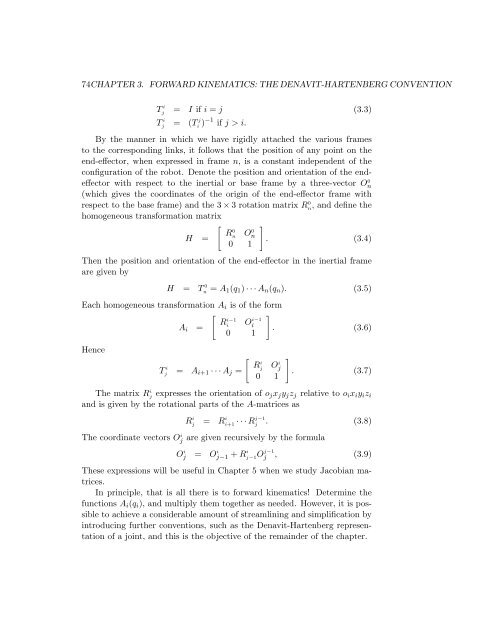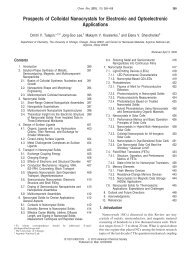FORWARD KINEMATICS: THE DENAVIT-HARTENBERG ...
FORWARD KINEMATICS: THE DENAVIT-HARTENBERG ...
FORWARD KINEMATICS: THE DENAVIT-HARTENBERG ...
Create successful ePaper yourself
Turn your PDF publications into a flip-book with our unique Google optimized e-Paper software.
74CHAPTER 3. <strong>FORWARD</strong> <strong>KINEMATICS</strong>: <strong>THE</strong> <strong>DENAVIT</strong>-<strong>HARTENBERG</strong> CONVENTION<br />
T i<br />
j = I if i = j (3.3)<br />
T i<br />
j = (T j<br />
i ) −1 if j > i.<br />
By the manner in which we have rigidly attached the various frames<br />
to the corresponding links, it follows that the position of any point on the<br />
end-effector, when expressed in frame n, is a constant independent of the<br />
configuration of the robot. Denote the position and orientation of the end-<br />
effector with respect to the inertial or base frame by a three-vector O 0<br />
n<br />
(which gives the coordinates of the origin of the end-effector frame with<br />
respect to the base frame) and the 3 × 3 rotation matrix R 0<br />
n, and define the<br />
homogeneous transformation matrix<br />
�<br />
H =<br />
R 0<br />
n O 0<br />
n<br />
0 1<br />
�<br />
. (3.4)<br />
Then the position and orientation of the end-effector in the inertial frame<br />
are given by<br />
H = T 0<br />
n = A1(q1) · · ·An(qn). (3.5)<br />
Each homogeneous transformation Ai is of the form<br />
�<br />
R<br />
Ai =<br />
i−1<br />
i O i−1<br />
�<br />
i . (3.6)<br />
0 1<br />
Hence<br />
T i<br />
j = Ai+1 · · ·Aj =<br />
�<br />
R i<br />
j O i<br />
j<br />
0 1<br />
�<br />
. (3.7)<br />
The matrix R i<br />
j expresses the orientation of ojxjyjzj relative to oixiyizi<br />
and is given by the rotational parts of the A-matrices as<br />
The coordinate vectors O i<br />
j<br />
R i<br />
j = R i<br />
i+1 · · ·R j−1<br />
j . (3.8)<br />
are given recursively by the formula<br />
O i<br />
j = O i<br />
j−1 + R i<br />
j−1O j−1<br />
j , (3.9)<br />
These expressions will be useful in Chapter 5 when we study Jacobian matrices.<br />
In principle, that is all there is to forward kinematics! Determine the<br />
functions Ai(qi), and multiply them together as needed. However, it is possible<br />
to achieve a considerable amount of streamlining and simplification by<br />
introducing further conventions, such as the Denavit-Hartenberg representation<br />
of a joint, and this is the objective of the remainder of the chapter.
















